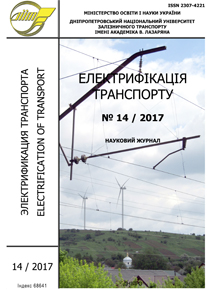Interaction simulation methodology of pantograph - contact wire
DOI:
https://doi.org/10.15802/etr.v0i14.155082Keywords:
contact network, pantograph, contact wire, dynamic interaction, modelingAbstract
The modern types of models for calculating the dynamic interaction of a contact wire and current collectors can be divided into analytical and imitation [1]. Analytic models are referred to models with lumped and distributed parameters. The former do not satisfy the increased need for the accuracy of the calculation of the dynamic interaction of the pair, the-receiver-contact wire. The sphere of their use can only be separated by engineering calculations. Second, the models taking into account the distributed parameters, allowing to obtain on the output a whole set of information about the current collection process such as: contact pressing, points and time of tearing off the susceptor, the amplitude of the oscillations, the coordinates of the point of contact pantograph - the contact wire. The disadvantage of these models is the high order of the resulting system of equations.
The technique developed in this work allows taking into account excitations of the system at different points simultaneously, which requires the determination of the modal damping coefficient, which is a function of frequency. Using the excitatory force as a basis, the corresponding differential equation is solved for all natural frequencies, and the results for individual frequencies are superimposed to obtain the overall response of the contact wire system.
To determine the trajectory of motion of points, a differential equation of motion is developed that applies time-independent matrix systems, and does not require a large amount of computation to model the force of pressing. Thus, it is only necessary to perform calculations once for the given configuration of the contact wire
References
Domanskij, I. V. Modelirovanie vzaimodejstvija kontaktnoj seti i tokopriemnikov s pri-meneniem chastotno-zavisimyh konechnyh jelementov i uchetom vzaimosvjazi mehanicheskogo i jelektricheskogo rascheta podvesok / I. V. Domanskij // Zalіznichnij transport Ukraїni : naukovo-praktichnij zhurnal. - 2011. - № 5. - S. 9-14.
Liubarskyi B.H. Teoretychni osnovy dlia vyboru ta otsinky perspektyvnykh system elektromekhanichnoho peretvorennia enerhii elektrorukhomoho skladu : dys. … doktora tekhn. nauk : 05.22.09 / Liubarskyi Borys Hryhorovych. – Kharkiv : NTU «KhPI», 2014. – 368 s.
Fischer W. / Eine Methode zur Berechnung des Schwingungsverhaltens von Kettenwerk und Stromabnehmer bei hohen Zuggeschwindigkeiten (A method to calculate the vibra¬tion behaviour of overhead contact line and pantograph at high running speeds) / W. Fischer. TH Darmstadt 1975, dissertation thesis.
Hobbs A. E. W. / Accurate prediction of overhead line behaviour / A. E. W. Hobbs. In: Railway Gazette International (1977)9, pp. 339 - 343.
Kiesling F. Contact lines for electric railways planning design implementation. Berlin and Munich. Siemens / Kiesling F., Puschman R., Schmieder A., 2001. – 822 p.
Brodkorb A. Simulationsmodell des Systems Stromabnehmer-Oberlei-tungskettenwerk (Model for the simulation of the interaction between overhead contact line and pantograph) / A. Brodkorb, M. Semrau // In: Elektrische Bahnen 91(1993)4, pp. 105 to 113.
Link M. Zur Berechnung von Fahrleitungsschwingungen mit Hilfe frequenzabhangiger finiter Elemente (Calculation of overhead contact line vibrations by means of frequency dependent finite elements) / M. Link. Ingenieur-Archiv 51(1981), pp. 45 to 60.
Maksimchuk V.F. Rezul'taty modelirovanija vzaimodejstvija kontaktnoj seti i tokopriemnikov na jeksperimental'nom uchastke skorostnogo dvizhenija napravlenija Kiev - Poltava - Doneck. Ocenka staticheskih i dinamicheskih parametrov / V. F. Maksimchuk, I. V. Domanskij // Zalіznichnij transport Ukraїni : naukovo-praktichnij zhurnal. - 2012. - № 1. - S. 25-31
Published
Issue
Section
License
При направленні статті в редакцію, автор гарантує, що стаття надається для публікації уперше і раніше не була опублікована в інших виданнях повністю або частково.
Підписанням ліцензійного договору автор(и) підтверджує(ють), що має(ють) виняткове авторське право на статтю і передає(ють) невиняткові права на свою статтю видавництву журналу «Електрифікація транспорту» для публікації в черговому номері журналу. Автор(и) так само дає(ють) згоду на передачу і розміщення електронної версії своєї статті на сайтах баз даних, створюваних і поширюваних через Інтернет.
